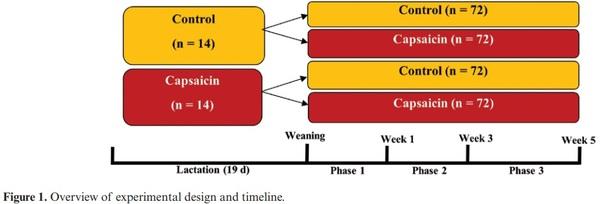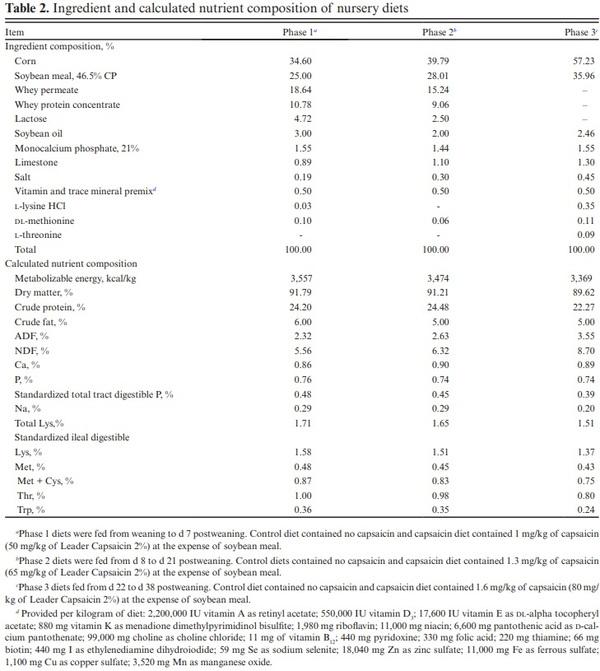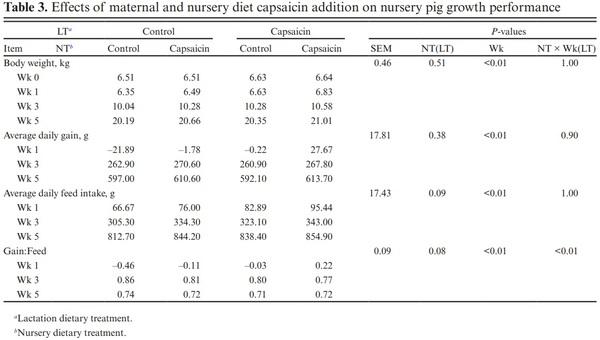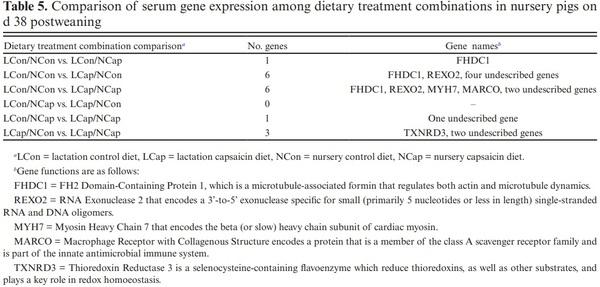INTRODUCTION
One of the greatest challenges in optimizing growth performance and health of newly weaned pigs is to overcome low and variable feed consumption which adversely affects gastrointestinal health during this critical transition period on commercial swine farms (Pluske et al., 1997; Langendijk et al. 2007; Dong and Pluske, 2007). Therefore, dietary interventions that encourage faster adaptation and greater feed consumption, while also improving energy and nutrient digestibility in newly weaned pigs are needed (Dong and Pluske, 2007). Numerous types of feed additives are commercially available and used as potential replacements for growth promoting antibiotics in diets for weaned pigs to enhance growth and health postweaning. Essential oils and plant extracts have become increasingly popular choices in nursery diets because of their capability of enhancing digestive enzyme secretions and nutrient absorption, reducing gut pathogens, providing antioxidant properties, and improving immune status (Zeng et al., 2015). Capsaicin is a biologically active plant extract derived from the genus Capsicum (chili peppers) and has antimicrobial, antiobesity, anti-inflammatory, antioxidant, and anti-cancer properties in humans and animals when supplemented in the diet (Zimmer et al., 2012; Clark and Lee, 2016; Zheng et al., 2017). Capsaicin is passively absorbed in the stomach and the upper portion of the small intestine with more than 80% efficiency (Kawada et al., 1984). Results of experiments have demonstrated that feeding capsaicin enhances digestive enzyme secretion through neurostimulatory activity (Maggi et al., 1987; Platel and Srinivasan, 1996; Maji and Banerji, 2016), and capsaicin can also provide potent antioxidant activity in vitro (Kogure et al., 2002). Dietary capsaicin and other spice compounds also enhance lipid digestion and absorption from diets high in lipid content by enhancing secretion of bile salts and stimulating the activity of pancreatic lipase (Prakash and Srinivasan, 2012).
However, because many commercially available botanical extracts are mixtures of various compounds, it is difficult to differentiate the relative contribution of each compound to the growth and health responses observed. A limited number of studies have evaluated the effects of feeding blends of botanical extracts containing various concentrations of capsaicin to gestating and lactating sows, and have demonstrated improvements in sow and litter performance (Ilsley et al., 2003; Matysiak et al., 2012), along with increased gene expression associated with integrity of intestinal membranes, tight junctions, and immune responses in weaned pigs (Liu et al., 2013a, b; Liu et al., 2014a, b). Only two studies have been conducted to evaluate the sole addition of capsaicin to sow and weaned pig diets. Paraksa (2011) reported positive effects on passive immunity of piglets nursing sows supplemented with up to 10 mg/kg of capsicum crude extract in their gestation and lactation diets, and Rujirapong et al. (2010) fed diets containing 5 mg/kg capsicum to weaned pigs and demonstrated improvements in average daily gain (ADG), average daily feed intake (ADFI), and gain:feed (G:F) compared with pigs fed diets containing no capsicum.
It may be possible that some feed additives, such as capsaicin or other botanical extracts, can be supplemented in lactating sow diets to encourage faster adaptation and consumption of dry diets of their offspring immediately after weaning if these compounds are present in sow milk during the nursing period (Bolhuis et al., 2009; Oostindjer et al., 2010). Although evidence for this potential benefit is limited, Charal et al. (2016) found that supplementing diets with anise oil for lactating sows and their offspring after weaning, may improve ADFI of pigs during the first days after weaning. However, there are no studies that have evaluated the effects of feeding capsaicin to lactating sows and the subsequent effects on growth performance and gene expression of their offspring fed diets without and with capsaicin postweaning. Therefore, the objectives of this study were to determine the potential carry-over effects of pigs nursing sows fed capsaicin diets on postweaning growth performance and gene expression compared with offspring from sows without dietary capsaicin supplementation but only fed capsaicin during the postweaning nursery period. We hypothesized that adding capsaicin to lactating sow and subsequent nursery pig diets would improve feed intake of weaned pigs during the critical first wk postweaning.
MATERIALS AND METHODS
The University of Minnesota Institutional Animal Care and Use Committee (Protocol No. 1812-36585A) approved all the experimental procedures used in this study.
Facilities and Animal Management
This study was conducted at the University of Minnesota West Central Research and Outreach Center (WCROC) located in Morris, MN in two phases using a 2 × 2 factorial arrangement of treatments. The lactation phase involved feeding corn-soybean meal-based diets with or without 2.5 mg/kg capsaicin to sows during a 19-d period, followed by the nursery phase where the weaned offspring were fed diets without and with capsaicin during a 38-d postweaning period to determine the effects of capsaicin on growth performance and gene expression.
Sow Feeding
Twenty-eight multiparous crossbred sows (Large White × Landrace; Topigs Norsvin, Burnsville, MN) from one farrowing group were used in this study. Sows were allotted randomly to one of two corn-soybean meal-based diets that were formulated to meet or exceed NRC (2012) requirements for lactating sows using previous sow productivity data for this research herd (Table 1). Fourteen sows were fed a diet containing 2.5 mg/ kg capsaicin (Leader Capsaicin 2%, Leader BioTechnology Co., Ltd, Guangzhou, China) and another 14 sows were fed the same diet but without capsaicin. All sows were housed in individual farrowing crates (1.5 × 2.0 m) and were provided ad libitum access to experimental diets and water from the day of farrowing until weaning (19.18 ± 1.16 d). Piglets were processed according to the WCROC standard operating procedures and cross-fostered within each treatment to standardize litter weights and litter size (>11 pigs) within 48 h after farrowing.
Nursery Experimental Design
At weaning, pigs were transferred to the WCROC confinement nursery facility and were provided ad libitum access to feed and water during the 5-wk experiment. Each pen (2.4 × 1.2 m) consisted of plastic grated flooring, one cup drinker, and one 4-hole stainless steel feeder (Hog Slat Inc., Newton Grove, NC). A total of 318 pigs were weaned from the 28 sows in previously described farrowing group, and 288 pigs were selected to be blocked according to body weight (BW) and balanced by lactation dietary treatment across 36 pens. Each pen contained 8 pigs with no more than two littermates in each pen. Each block was assigned to one of four dietary treatments (lactation control— LCon and nursery control—NCon; LCon and nursery capsaicin—NCap; lactation capsaicin—LCap and NCon; LCap and NCap) to provide nine replications per treatment using a 2 × 2 factorial arrangement of treatments (Figure 1).
A 3-phase nursery feeding program was used, where phase 1 diets were fed from weaning to d 7, phase 2 diets were fed from d 8 to 21, and phase 3 diets were fed from d 22 to 38 postweaning, with or without 1.0, 1.3, and 1.6 mg/kg capsaicin, respectively. All diets met or exceeded recommended NRC (2012) nutrient requirements using the NRC model for pig BW in each phase (Table 2). Individual pig BW and pen feed disappearance were determined and recorded at each dietary phase change.
Growth Performance Data Collection
All experimental pigs were weighed individually at weaning, and at the end of each diet phase for wk 1, 3, and 5 postweaning. Pen feed disappearance was determined on the same day by subtracting the weight of any feed remaining in feeders from the total amount added to feeders during each respective phase period. Pen BW and feed disappearance data from each phase were used to calculate ADG, ADFI and gain efficiency (G:F) for each phase and at 35-d of the overall feeding period. Pig mortalities were recorded to include the date, BW, and dietary treatment.
Blood Sample Collection
All pigs remained on their respective dietary treatments for an additional 3-d, and on d 38 postweaning, one barrow closest to the pen mean BW (n = 36) in each pen was selected for collection of blood samples to determine if there were differences in gene expression among dietary treatments. Immediately after sampling, blood was transferred to another tube with an RNA shield solution. Each tube was labeled with piglet ear tag number and stored at 4 °C until analysis.
RNA Extraction and Gene Expression
Total RNA from whole blood was extracted using a kit (Quick-RNA Whole Blood; Zymo Research, Irvine, CA) according to the manufacturer’s instructions. The quantity of RNA in each sample was measured by a Nano spectrometer (NanoPhotometer N60, Implen, Westlake Village, CA). The RNA quality was assessed using gel electrophoresis by the QiAxel Advanced System device (Qiagen, Hilden, Germany), and 16 samples with the best RNA quality ratio were selected and sent to the University of Minnesota Genomics Center for analysis. Library prep was performed using a TakaraBio Clontech pico mammalian kit (SMARTer Stranded total RNA-seq Pico Input Mammalian kit, Takara Bio USA Inc., Mountain View, CA) to maximize quality reads. Fifteen samples successfully passed library quality control. Sequencing was performed with 4 replicates per group, except for the LCon/NCap group which had three replicates.
The RNA-seq was performed on an Illumina Novaseq instrument with 50 nucleotide paired-end sequencing averaging 25 million reads per sample. Reads were trimmed using FastQC and aligned to the pig genome, Sus scrofa v11.1 using HISAT2, with all samples having between 10 and 15 million uniquely mapped reads. For each mapped transcript, a minimum of three replicates were required to have greater than zero read counts, after which, all sample replicates were averaged per transcript. Differential gene expression was based on detecting any gene with >2× absolute fold change cutoff and with False Discovery Rate (FDR) corrected P-values of <0.05.
Statistical Analysis
Nursery growth performance data were analyzed using SAS (v 9.4; SAS Inst. Inc., Cary, NC). The model in the Mixed Procedure included the nursery dietary treatment nested within sow lactation treatment. The repeated statement of SAS was used with pen as experimental unit, and covariance structure was modeled using the autoregressive function. The final model was selected based on the Bayesian Criterion. All data were evaluated for outliers, normal distribution, and variances using the univariate procedure of SAS. The pen served as the experimental unit. Nursery BW coefficient of variation (%CV) was also calculated. Pair-wise comparisons among dietary treatment groups were used for determining significant differences in gene expression. Differences were considered when P ≤0.05, and a trend when 0.05 < P ≤ 0.10.
RESULTS AND DISCUSSION
Lactation Performance
Due to the limited number of sows (replications) per treatment (n = 14), there was not enough statistical power to accurately determine meaningful differences in sow and litter performance between control and capsaicin dietary treatments. Based on Aaron and Hays (2004), assuming a coefficient of variation (CV) of 36.9% for the number of pigs weaned as a variable with a desired difference of at least 12%, and with 80% power and a significance level of 5%, the estimated number of sows per treatment was estimated to be approximately 134 sows.


However, there was a trend (P = 0.11) for sows fed the capsaicin diet to consume less feed (6.92 kg/d) compared with sows fed the control diet (7.52 kg/d), which resulted in greater sow BW loss (P < 0.05) and backfat loss (P < 0.05) than sows fed the control diet. There were no differences in number of pigs born, born alive, stillborn, and weaned, nor were there differences in individual piglet and litter birth weight, weaning weight, and mortality between treatments. The optimal inclusion rate of capsaicin has not been determined for sow lactation diets. However, Ilsley (2003) and Matysiak (2012) found no effects on sow performance with diet inclusion rates of 2.2 and 2.0 mg/kg of capsaicin, respectively (as a part of a blend of plant extracts). Paraksa (2011) reported that inclusion rates between 0 and 20 mg/kg in sow gestation and lactation diets did not decrease feed intake. This may suggest that the inclusion of 2.5 mg/kg of capsaicin used in this experiment was in excess of optimal dietary levels and requires further evaluation.
Nursery Growth Performance
Low and variable feed intake after weaning commonly occurs in commercial pork production systems and is an important issue requiring solutions to achieve optimal health and growth performance of weaned pigs (Dong and Pluske, 2007). Holzer (1998) and Takeuchi et al. (1991) indicated that capsaicin-sensitive afferent neurons in stomach can be activated when capsaicin is consumed, and these neuronal mechanisms play a central role in regulating various gastric functions such as secretion, mucosal blood flow and motility, and modulate mucosal integrity. Furthermore, Zeng et al. (2019) showed that pigs exhibiting high ADG during the nursery period have greater likelihood of reaching full-market value compared with their slower growing contemporaries in the nursery. Therefore, we hypothesized that adding capsaicin to lactating sow and subsequent nursery diets may improve feed intake of weaned pigs during the critical first wk postweaning.
There were no differences in pig BW at weaning or at the end of wk 1, 3, and 5, nor were there differences in ADG and ADFI among dietary treatments (Table 3). However, there was a dietary treatment × wk interaction (P < 0.001), where pigs from the LCap/NCap treatment had greater G:F, compared with pigs from LCon/NCon, with the LCon/NCap and LCap/NCon treatments being intermediate. Under the conditions of this experiment, it is difficult to know if the differences in G:F during wk 1 is a result of greater ADG or reduced ADFI with a similar unit of BW gain. Future experiments are needed to determine the associated cause of the improvement in G:F during wk 1 postweaning. A similar response was reported by Charal et al. (2016), where feeding anise oil to lactating sows increased the feed intake of nursery pigs after weaning. However, our results differ from those reported by Rujirapong et al. (2010), where feeding diets containing 5 ppm capsicum to weaned pigs resulted in improved ADG, ADFI, and G:F compared with pigs fed diets containing no capsicum.
There was a trend for greater ADFI (P < 0.09) and G:F (P < 0.08) responses from capsaicin feeding based on nursery treatment nested within lactation treatment responses, suggesting that there appears to be a beneficial carry-over effect postweaning for pigs that were nursing sows fed capsaicin on ADFI and G:F compared with those from sows fed the nonsupplemented diet, and the effect is greater when pigs continued to be fed capsaicin diets after weaning. There are likely multiple mechanisms involved that may explain how the supplementation of sow lactation diets with capsaicin may increase feed intake of the offspring postweaning. These include secretion of capsaicin and capsaicin metabolites in milk, excretion in feces, or through direct consumption of sow diets by pigs during the lactation period that may allow newly weaned pigs to recognize the nursery pig diet as familiar (Oostindjer et al., 2010).
However, the improvements in ADFI and G:F from capsaicin exposure did not result in an overall increase in BW at the end of the 35-d nursery feeding period. In fact, the CV in pig BW appeared to be greater at the end of wk 3 and wk 5 postweaning for pigs exposed to capsaicin while nursing sows and/or pigs that were consuming capsaicin during the nursery period compared with pigs with no capsaicin exposure from birth to 35-d postweaning (Table 4).
Gene Expression
The apparent differences in growth performance, along with the interactive effects of time of capsaicin exposure, led us to evaluate potential differences in gene expression using blood samples collected from each of the four treatment combinations on d-38 of the nursery period. In comparison to the LCon/NCon treatment, nursery pigs from the capsaicin treated sows (LCap/NCon and LCap/NCap) had the most gene expression changes (n = 6; Table 5). Although the number of differentially expressed genes is small, these results indicate that either targeted changes occurred, or the biological effect was small.
The largest number of differentially expressed genes occurred in nursery offspring from sows fed capsaicin during lactation compared with sows and nursery pigs with consumption of capsaicin. Differential gene expression was less in nursery pigs from sows fed the control diet regardless of whether they were fed capsaicin diets during the nursery period. Upregulated and downregulated differential expression of genes is detailed in Table 6. Genes FHDC1, REXO2 and MYH7 were downregulated when sows were fed capsaicin during lactation, and gene TXNRD3 was downregulated when pigs were fed capsaicin after weaning. In this study, only a few undetermined genes were upregulated. These results indicate that feeding capsaicin to sows during lactation promotes similar gene expression changes as when feeding capsaicin to pigs post-weaning compared with responses from sows and nursery pigs fed the control diets. The overlap in differentially expressed genes between LCon/NCon and LCap and NCap pig groups indicates a shared pathway of induced genes by treatment, which is independent of treatment timepoint. The greater number of differentially expressed genes in the LCap group also indicate a stronger effect of lactation intake of capsaicin in nursery pigs than NCap.


Several genes were detected in our analysis, but they have no previously described known function. Overall, capsaicin appeared to have a small, but consistent impact on gene expression when compared with pigs exposed to diets without capsaicin. Liu et al. (2014a,b) obtained an expression differentiation of 490 genes in ileal mucosa of pigs fed 10 mg/kg of capsaicin in comparison with pigs fed the diet without capsaicin. In contrast, we obtained differences in expression of only 12 genes, but this was likely a result of only collecting in whole blood samples of nursery pigs fed among 1–1.6 mg/kg of capsaicin to compare with samples from pigs fed with nursery control diets.
In conclusion, the addition of capsaicin to diets of lactating sows and their weaned offspring appears to improve gain efficiency during the first wk postweaning and may be a useful dietary intervention for overcoming low and variable feed intake which commonly occurs immediately after weaning. Although the number of genes showing differential expression was small among dietary treatment combinations in our study, these results may encourage additional studies to further investigate the opportunity to achieve greater growth performance responses of nursery pigs during the first week after weaning by feeding sows capsaicin diets during lactation.
This article was originally published in Translational Animal Sciences 2021.5:1-9. https://doi.org/10.1093/tas/txab201. This is an Open Access article distributed under the terms of the Creative Commons AttributionNonCommercial License (https://creativecommons.org/licenses/by-nc/4.0/). 

















.jpg&w=3840&q=75)